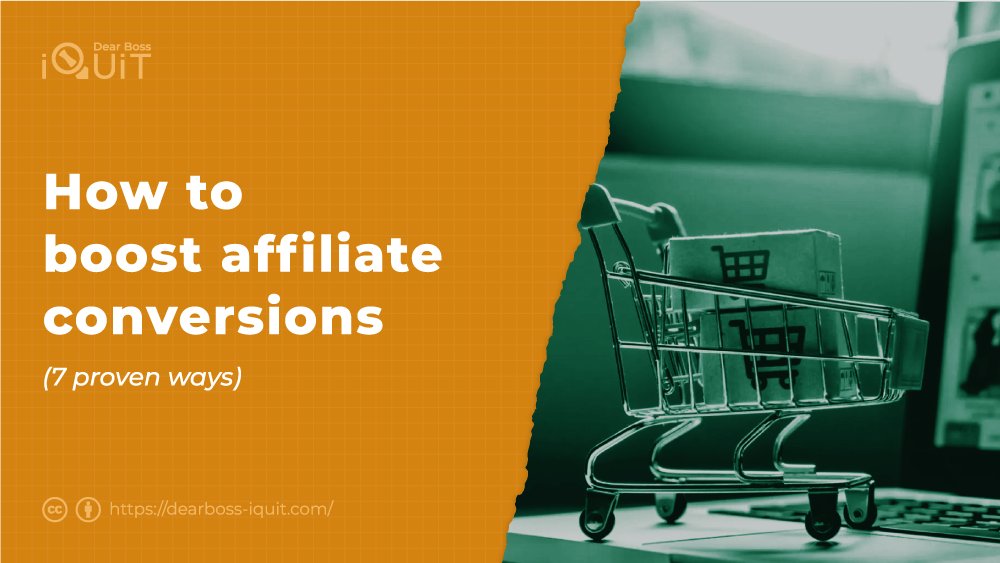Affiliate conversion rate optimization is one of the best and most cost-effective methods of boosting your affiliate sales.
That’s primarily because CRO doesn’t involve acquiring new customers but rather improving mostly on-page elements that would convert a higher percentage of your already existing leads into buyers.
While there are tons of methods to increase your affiliate conversions, in this article, I’ll share with you seven beginner-friendly ones I’ve tried and tested myself over the years:
- Split testing
- Use visual media
- Publish product reviews
- Employ bars and banners
- Implement exit intent pop-ups
- Track your metrics
- Leverage social media ads
Let’s take a closer look.
1. Split Testing
Split testing (a.k.a. A/B testing or multivariate testing) is one of the most efficient methods for increasing affiliate conversions.
The process consists of serving your audience two different versions of an entire web page or page element to determine which generates the highest conversion rates.
To give you an example, let’s say that you have a landing page with a yellow call-to-action button that converts at 10% and you’d like to find out whether, and how much, changing the button’s color to red would increase or decrease your conversion rates.
To do that, you simply create a variation of that same landing page that has a red call-to-action button and you serve it to half of your users, usually by using some kind of A/B testing software.
After running this experiment for a month, you discover that the red button converts at 20%, so you decide to permanently change its color from yellow to red.
The more split-testing experiments you run, the more accurately you’ll be able to identify customer engagement problems and make informed decisions regarding changes that could significantly improve your conversion rates.
Besides boosting the conversion rates of a website, web page, or web element, A/B testing can also be leveraged towards improving the affiliate conversions of social media posts, paid ad campaigns, marketing emails, etc.
Best Affiliate Marketing Courses
Best Affiliate Courses
2. Use visual media
Another way to improve your affiliate conversions is by incorporating relevant media into your content, such as:
- Images
- Videos
- Infographics
- etc
Adding visual elements when appropriate, will make your content much more readable, engaging, and appealing, especially to mobile users.
Moreover, many studies have shown that content with relevant visual elements can deliver anywhere between five to ten times higher conversion rates than plain text.
3. Publish product reviews
An additional great approach to increasing your affiliate conversions is writing and publishing product reviews.
According to GlobeNewswire, 95% of online consumers pay close attention to reviews before purchasing a product.
Such people are inherently much closer to converting and making a purchase than, let’s say, those who’re still in the phase of trying to figure out how to solve the problem they’re facing.
Moreover, product reviews can expand your website’s organic reach and subsequently, facilitate your overall SEO efforts.
Furthermore, you can also leverage product reviews toward creating product roundups.
Based on Affilimate, product roundups have the potential to deliver hundreds of times higher conversion rates than plain product reviews.
Lastly, product roundups can help you determine which of the affiliate products you endorse are in higher demand so that you can start devoting more of your resources to promoting them, rather than others that might not perform as well.
4. Employ bars and banners
A reason your affiliate conversions aren’t as high as you’d like might be that your website lacks apparent CTAs.
To counter that, you can start conducting your affiliate promotions on global floating bars and banners placed on your website’s sidebar or throughout your content.
According to Popup Maker, floating bars can increase affiliate conversions by up to 845%.
Sidebar banners are definitely not as effective mostly because nowadays, the majority of web traffic is generated via mobile devices where sidebars are usually hidden.
A word of caution…
Avoid filling your website with many floating bars and flashy sidebar banners, or else you’ll probably end up damaging its overall user experience and hurting your conversion rates.
5. Implement exit intent pop-ups
An exit intent pop-up is a type of popup that’s displayed when a user attempts to close or navigate away from your website.
Exit popups are excellent at capturing the attention and converting visitors that would otherwise leave your business empty-handed.
According to Venture Harbour, utilizing exit popups could boost your affiliate conversions by an average of 5-10%.
Exit intent pop-ups usually consist of captivating imagery and text along with a clear-cut CTA that directs users to an informational article, a sales page, an affiliate product, an email list, or practically any resource that’s meant to convert them into buyers.
For example, let’s say your affiliate website focuses on promoting a SaaS product that helps people manage their finances.
Your exit popup could gear towards enticing those who’re about to leave your website to purchase your product by providing a substantial discount, strong social proof, or access to a free trial.
Ideally, you should A/B test your popup to determine what performs the best.
Please note that exit-intent popups don’t get served to mobile users because mobile devices can’t track exit triggers
6. Track your metrics
Tracking your metrics is crucial to being able to maximize your affiliate conversions.
Some of the metrics you need to pay close attention to are:
- Click-through rate (CTR)
- Bounce rate
- Time on page
- Return on investment (ROI)
- New visitor conversion rate
- Returning visitor conversion rate
All of those metrics can be gathered via Google Analytics.
On top of that, you can also start tracking your affiliate links through the affiliate dashboard of each merchant whose products you promote.
Once you’ve got your hands on all the required data, you need to figure out how to summarize, analyze, combine, and compare it to draw conclusions regarding the behavior of your website traffic and how to turn it into actual sales.
7. Leverage social media ads
Last, but not least, an excellent way to increase affiliate conversions is by leveraging social media ads.
Unlike traditional advertising methods, social media ads allow you to reach out to specific target groups based on demographics, location, interests, internet activity, etc.
This way you can get your affiliate business in front of social media users who are highly likely to be interested in finding out more or purchasing the affiliate products or services you promote.
Each social media platform consists of different types of audiences that have different needs, so you might have to experiment with a few of them before you find which one delivers the best results for your business.
Paid social media ad campaigns can be costly but they have the potential of drawing highly targeted traffic to your affiliate offers instantaneously.
Affiliate marketing FAQs
Affiliate marketing is an online business model that involves promoting products or services created and distributed by third-party online merchants in exchange for getting paid a commission for each sale you refer.
In layman’s terms, affiliate marketing is the process of being compensated for helping businesses sell to more customers.
Here’s a bird’s eye view of how affiliate marketing works.
- You join a merchant’s affiliate program
- The merchant gives you a unique affiliate link that points to their e-shop
- You promote your unique affiliate link online (blog, forums, social media, paid ads, etc.)
- Every time someone clicks on your unique affiliate link and makes a purchase on the merchant’s e-shop, the merchant pays you a commission
There are thousands of successful affiliate marketers all around the world. Some of the most well-known ones are:
- Pat Flynn
- Matt Diggity
- Matthew Woodward
- Doug Cunnington
- & more
You can check out a roundup of my 17 favorite examples of affiliate success and their backstories right here.
- Billion-dollar industry
- Very low startup & operational expenses
- Huge income potential
- Flexible & versatile
- Passive income
- Simple to implement
- No technical background
- No customer support
- No physical setup
Affiliate marketers can be divided into five main income groups:
- Total beginners: $0 – $20,000 per year
- Low-level affiliates: $20,000 – $50,000 per year
- Intermediate affiliates: $50,000 – $100,000 per year
- High-level affiliates: $100,000 – $500,000 per year
- Super affiliates: $500,000+ per year
According to PayScale, the average annual income for affiliate marketers in the US is over $54,000 per year. Statistics reveal that 13% of affiliates earn more than $75,000 per year.
Some of the factors that influence how much you earn as an affiliate marketer include:
- seniority
- target niche
- available resources
- previous experience
- marketing efforts
- & overall mindset
Here’s a rough income growth timeline of a typical affiliate marketing business:
- months (0-3): no earnings
- months (3-6): first affiliate sale
- months (6-12): $100-$500 monthly
- months (12-18): $1000 monthly
- months (18-24): $3000+ monthly
This timeline isn’t a guarantee of future performance but rather a mere approximation of the income growth of an average affiliate business. Your own timeline could be shorter or longer than projected.
Over the years, I’ve seen aspiring affiliates striking a gold vein just a few months into the industry. On the other hand, I personally know people who’ve been struggling to grow their affiliate revenue to $1000 per month for several years.
Affiliate marketing is one of the most affordable money-making models out there.
Here’s a breakdown of everything you need to get started as an affiliate marketer along with their associated costs:
- web hosting & domain name: $2.95/month (Bluehost)
- keyword research tool: $49/month (Jaaxy)
- expert guidance: $49/month (Wealthy Affiliate)
- email autoresponder: Free for up to 1000 subs (MailerLite)
Please note that on top of expert guidance, Wealthy Affiliate also provides free access to hosting and a keyword research tool so you don’t have to purchase them separately.
Yes, you can do affiliate marketing without a website by promoting your affiliate links on other marketing channels, such as:
- Social Media
- Paid Ads
- YouTube
- Podcast
- etc.
The process of getting started with affiliate marketing can be broken down into the following four simple steps:
- Pick a niche
- Launch a blog
- Build an audience
- Promote affiliate products
No, you don’t.
Affiliate marketing is very simple to get started with by virtually anyone regardless of age, education, background, available capital, tech-savviness, professional network, etc.
In fact, most 6-figure affiliate marketers were no more experienced than you currently are when they first ventured into the affiliate marketing industry.
Nonetheless, being knowledgeable in fields like marketing, sales, content production, business management, etc., could help you reach your financial goals somewhat faster.
Conclusion
Many seasoned marketers claim that the hardest part of achieving affiliate success is acquiring traffic.
However, the more experience I gain in affiliate marketing, the more convinced I become that its most challenging aspect is converting the traffic you receive into actual paying customers.
As such, I strongly believe that investing resources in optimizing your affiliate conversions is vital to maximizing your income as an affiliate marketer.
Hopefully, the seven tips I shared with you in this article will help you improve your affiliate conversions, boost your affiliate sales, and attain higher returns on the time and effort you invest in growing your business.
If you have any questions or require further help, leave a comment right below or contact me right here, and I’ll do my best to get back to you as soon as possible.
Happy converting!
Harry, Founder & Creative Director at dearboss-iquit.com




